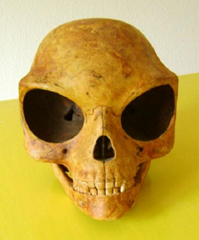An alien from a survivor " ; ufo-crash "prehistoric? An unfortunate time traveler from the future? A merchant from a parallel universe? A species so far sconosciuta? Oppure una semplice deformità di un essere umano? Nessuno ancora lo sa per certo, ma non importa la spiegazione, il Teschio Sealand ha il potenziale per cambiare la visione del mondo in cui viviamo. Nel luglio del 2007 il ritrovamento del cranio in Olstykke sull'isola danese Sealand, tuttavia, non ha fatto notizia ed è rimasta in gran parte ignorata dalla scienza fino al 2010. I ricercatori che nel 2008 hanno esaminato il cranio al veterinario High School di Copenaghen, semplicemente han concluso che anche se simile a un mammifero, alcune caratteristiche rendono impossibile montare la tassonomia degli animali sinora conosciuti. Scavato durante la sostituzione delle vecchie condotte di scarico, si era pensato in un primo momento che fosse qualche osso horse, as the house formerly belonged to a butcher's horse, and the garden was full of ruins. Until the filling of the trench has anyone noticed his humanoid form.
Later excavations at the site have unearthed the remains further with some connection to the creature, only easily identifiable animal bones, stone axes and other tools that are common in the Neolithic. The fact that the skull was found among the remains of Neolithic did not reveal her age. A carbon-14 dating at the Niels Bohr Institute in Copenhagen showed that the creature lived between 1200 and 1280 AD. In addition, the skull was found on the tubes not so old, whose age suggests that it was not buried until after 1900. The absence of parts of the skeleton, along with the state of preservation of the skull, has led scientists to suspect that it was not buried for a long time, probably only a couple of decades. Maybe to hide the secret behind her existence someone has preserved for centuries and then deliberately buried. It 's interesting to note that residents of nearby villages have Olstykke and from ancient times has spoken of a local member of l'Ordre Lux Pegasos (The Order of Light Pegasus), which, therefore, on behalf of the Order run various items between that of a mysterious skull and multiple devices, made of light overtime, although metal or ceramic shatterproof. The skull is said to have originated from the Balkans, but has also been kept in Paris, France and Monaco of Bavaria, Germany, before arriving in Denmark. If the story is true, it is possible that further research may lead to the location of the alien artifacts. E 'Lux Pegasos plausible that the order still objects that allow us a better understanding of its origin and purpose. Little is known about the order though, just that it was established in 1350 and throughout his life has counted influential poets and writers among its members. The Skull of Sealand is about one and half times larger than a male Homo sapiens skull. Especially orbits contribute to its size. Its smooth surface reveals that the creature was adapted to cold climate, and its relative size eye that it was a nocturnal creature, lived in the basement or on a planet orbiting a star-up or weak, probably a red dwarf or orange. It is noted that the star 51 Pegasi in the constellation of Pegasus was the first Sun-like star known to have a planet. Planets in orbit around the star HR 8799 Pegasus were the first to be discovered, and spectroscopic analysis of HD 209458 b, another planet in the constellation, has provided the first evidence of atmospheric water vapor beyond our solar system.
.
source: www.unexplained-mysteries.com

0 comments:
Post a Comment